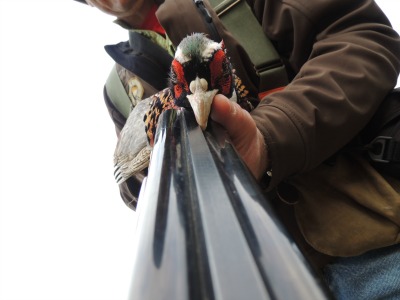Pheasants, on the farm and in the forest
By Gary Lewis
 "In the 1960s there were pheasants in all the fields."
"In the 1960s there were pheasants in all the fields." Terry Rodakowski, 62, of Junction City, thumbed cartridges into his Remington Wingmaster. "Back then, if you wanted a rooster for dinner, you just walked out and jumped them up."
We were on a forest path along a creek on the Upper Calapooia River near Crawfordsville in Western Oregon. There was a glint of the enthusiasm for the hunt that Terry must have had in the 1960s. He was going back into the field with his old shotgun.
Ringneck pheasants were introduced in the United States in the 1880s and were released first in the Willamette Valley. For most of the last century, the birds were common throughout the state. As urban sprawl and efficient farming practices took over; as hawks and owls, crows and ravens increased in number, the pheasant lost ground. Now, a wild rooster is a rare sight indeed.
Now, most pheasant hunts in Oregon take place on private preserves where birds are raised then released in good habitat.
When outdoor writer Troy Rodakowski, Terry's son, told me about a place called DK Wildlife Ranch, I was intrigued.
George and Jo Dern bought the 150-acre property in 1994 and started to rehabilitate the ground which had been clear-cut in the early '90s. To establish baseline data and gauge the advancement of their efforts, they began a bird survey to document avian changes as habitat improved.
Slash piles were burned, large areas of brambles and Scotch broom were cleared, snags and native vegetation was left for wildlife habitat.
Two years of data showed that bird species richness increased 32.5 percent from Year 1 to Year 2 while bird abundance increased 137 percent. Two decades later, the property retains a natural character, shaped by the Derns with multiple shelter belts of native cover for non-game wildlife and for hunting.
"We try to work with what nature gave us," George Dern said.
Dern and Jeff Lebow were the guides for our hunt. Troy brought his dad, Terry, I brought my friend Jack Young and his grandson, Hayden. Out of school on Christmas break, this would be 16-year-old Hayden's first pheasant hunt.
"I like to begin the hunts with a little warm-up," Dern said. "We start you off in the outhouse and when you break a clay pigeon, we let you out."
I took a box of target shells into the outhouse, where I stood in the doorway. Dern took his seat on the clay thrower. An orange target streaked through the trees, left to right, and I missed it. I missed the next two shots and then connected.
Some of our hunters shot better than me, some shot worse, but eventually we were all "toilet-trained" and could go hunting. Dern let Ellie, his 11-year-old pudelpointer, and two Hungarian vizslas off their leads. Beau, Young's French Brittany, started off at heel then began to quarter ahead.
We started on what Dern calls his "grouse walk," along the creek, through alders, firs and Oregon grape. There are blue grouse on the property, but it was a pheasant the dogs pointed. My toilet training paid off; the bird flushed left to right and I stopped it. Ellie, Dern's 11-year-old pudelpointer, made the retrieve. Minutes later Ellie locked up and the other dogs honored her point; Hayden walked in and the bird flushed straight away and he dropped his first rooster.
We crossed the creek into a field of Scotch broom broken by shelter belts of cottonwoods and Douglas firs.
 After we had eight pheasants in our game vests, I thought our hunt was over, but Dern, who turns 79 this year, said we were just getting started. By the time we were finished, we had 21 in the bag and we never hunted the same piece of ground twice.
After we had eight pheasants in our game vests, I thought our hunt was over, but Dern, who turns 79 this year, said we were just getting started. By the time we were finished, we had 21 in the bag and we never hunted the same piece of ground twice. Hayden marveled as each bird was brought to hand. No one rooster was like another. One bird's coloration tended toward greens and aquamarine, while another bird wore shades of blue. Each hen, too, was resplendent in muted browns and iridescent greens. We packed enough home for a dozen dinners.
These days, when we think pheasants, we picture prairies of wheat and rye and standing corn in wide-open spaces, but there was a time when farm kids chased roosters in fields and forest lands like this.


